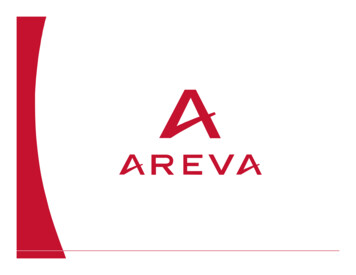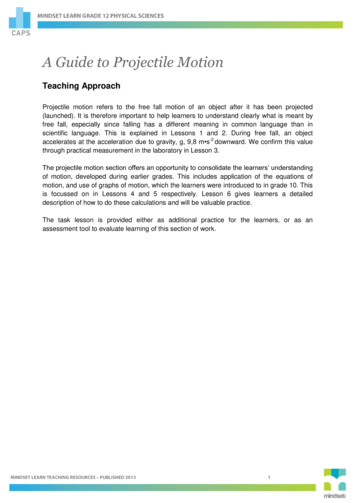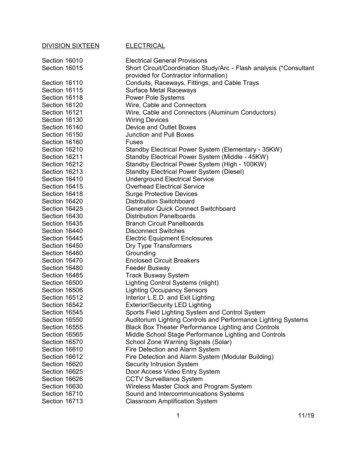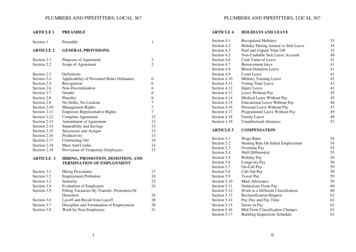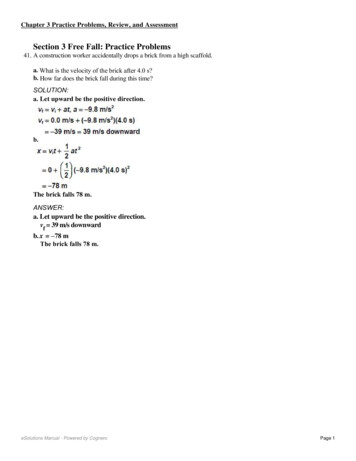
Transcription
Chapter 3 Practice Problems, Review, and AssessmentSection 3 Free Fall: Practice Problems41. A construction worker accidentally drops a brick from a high scaffold.a. What is the velocity of the brick after 4.0 s?b. How far does the brick fall during this time?SOLUTION:a. Let upward be the positive direction.b.The brick falls 78 m.ANSWER:a. Let upward be the positive direction.vf 39 m/s downwardb. x –78 mThe brick falls 78 m.44. A tennis ball is thrown straight up with an initial speed of 22.5 m/s. It is caught at the same distance above theground.a. How high does the ball rise?b. How long does the ball remain in the air? Hint: The time it takes the ball to rise equals the time it takes to fall.SOLUTION:a.b.eSolutions Manual - Powered by CogneroPage 1
a. Let upward be the positive direction.vf 39 m/s downwardb. x –78 mChapter3 PracticeProblems,Thebrick falls78 m. Review, and Assessment44. A tennis ball is thrown straight up with an initial speed of 22.5 m/s. It is caught at the same distance above theground.a. How high does the ball rise?b. How long does the ball remain in the air? Hint: The time it takes the ball to rise equals the time it takes to fall.SOLUTION:a.b.ANSWER:a. x 26 mb. t 4.6 s45. You decide to flip a coin to determine whether to do your physics or English homework first. The coin is flippedstraight up.a. What is the velocity of the coin at the top of its trajectory?b. If the coin reaches a high point of 0.25 m above where you released it, what was its initial speed?c. If you catch it at the same height as you released it, how much time did it spend in the air?SOLUTION:a. vtop 0 m/s; a top 9.8 m/s downwardb.eSolutions Manual - Powered by CogneroPage 2
ANSWER:a. x 3 26mChapterPracticeProblems, Review, and Assessmentb. t 4.6 s45. You decide to flip a coin to determine whether to do your physics or English homework first. The coin is flippedstraight up.a. What is the velocity of the coin at the top of its trajectory?b. If the coin reaches a high point of 0.25 m above where you released it, what was its initial speed?c. If you catch it at the same height as you released it, how much time did it spend in the air?SOLUTION:a. vtop 0 m/s; a top 9.8 m/s downwardb.c.ANSWER:a. vtop 0 m/s; atop 9.8 m/s downwardb. vi 2.2 m/sc. t 0.45 sSection 3 Free Fall: Review47. MAIN IDEA Suppose you hold a book in one hand and a flat sheet of paper in another hand. You drop them both,and they fall to the ground. Explain why the falling book is a good example of free fall, but the paper is not.SOLUTION:Free fall is the motion of an object when gravity is the only significant force on it. The paper issignificantly affected by the air, but the book is not.ANSWER:Free fall is the motion of an object when gravity is the only significant force on it. The paper issignificantly affected by the air, but the book is not.49. Free-Fall Ride Suppose a free-fall ride at an amusement park starts at rest and is in free fall. What is the velocityof the ride after 2.3 s? How far do people on the ride fall during the 2.3-s time period?SOLUTION:Let upward be the positive direction.eSolutions Manual - Powered by CogneroPage 3
significantly affected by the air, but the book is not.ANSWER:Free fall is the motion of an object when gravity is the only significant force on it. The paper isChapter3 PracticeProblems,significantlyaffectedby theReview,air, butandthe Assessmentbook is not.49. Free-Fall Ride Suppose a free-fall ride at an amusement park starts at rest and is in free fall. What is the velocityof the ride after 2.3 s? How far do people on the ride fall during the 2.3-s time period?SOLUTION:Let upward be the positive direction.ANSWER:Let upward be the positive direction.vf 23 m/s downwardx f 26 mThe people fall 26 m during the 2.3-s time period.51. Velocity and Acceleration Suppose you throw a ball straight up into the air. Describe the changes in the velocity ofthe ball. Describe the changes in the acceleration of the ball.SOLUTION:Velocity is reduced at a constant rate as the ball travels upward. At its highest point, velocity is zero. Asthe ball begins to drop, the velocity begins to increase in the negative direction. When it reaches theheight from which it was initially released, the ball has the same speed it had upon release. Theacceleration is constant throughout the ball’s flight.ANSWER:Velocity is reduced at a constant rate as the ball travels upward. At its highest point, velocity is zero. Asthe ball begins to drop, the velocity begins to increase in the negative direction. When it reaches theheight from which it was initially released, the ball has the same speed it had upon release. Theacceleration is constant throughout the ball’s flight.Chapter AssessmentSection 3 Free Fall: Mastering Problems72. A stone that starts at rest is in free fall for 8.0 s. (Level 1)a. Calculate the stone’s velocity after 8.0 s.b. What is the stone’s displacement during this time?eSolutions Manual - Powered by CogneroPage 4SOLUTION:a. vf vi atf where a 9.8 m/s2
ANSWER:Velocity is reduced at a constant rate as the ball travels upward. At its highest point, velocity is zero. Asthe ball begins to drop, the velocity begins to increase in the negative direction. When it reaches theheightfrom whichit was initiallythe ball has the same speed it had upon release. TheChapter3 PracticeProblems,Review,released,and Assessmentacceleration is constant throughout the ball’s flight.Chapter AssessmentSection 3 Free Fall: Mastering Problems72. A stone that starts at rest is in free fall for 8.0 s. (Level 1)a. Calculate the stone’s velocity after 8.0 s.b. What is the stone’s displacement during this time?SOLUTION:a. vf vi atf where a 9.8 m/s22 0.0 m/s ( 9.8 m/s )(8.0 s) 78 m/s 78 m/s downwardb. Choose the coordinate system to have the origin where the stone is at rest and positive to be upward. 3.1 102 m downwardANSWER:a. 78 m/s downwardb. 310 m downward74. You throw a ball downward from a window at a speed of 2.0 m/s. How fast will it be moving when it hits thesidewalk 2.5 m below? (Level 2)SOLUTION:Choose a coordinate system with the positive direction downward and the origin at the point where theball leaves your hand.ANSWER:Choose a coordinate system with the positive direction downward and the origin at the point where theball leaves your hand.76. Beanbag You throw a beanbag in the air and catch it 2.2 s later at the same place at which you threw it. (Level 3)a. How high did it go?b. What was its initial velocity?SOLUTION:a. Choose a coordinate system with the upward direction positive. The time to reach the maximum heightis half of the time in the air.eSolutions Manual - Powered by CogneroPage 5
ANSWER:Choose a coordinate system with the positive direction downward and the origin at the point where theball leavesyourProblems,hand.Chapter3 PracticeReview, and Assessment76. Beanbag You throw a beanbag in the air and catch it 2.2 s later at the same place at which you threw it. (Level 3)a. How high did it go?b. What was its initial velocity?SOLUTION:a. Choose a coordinate system with the upward direction positive. The time to reach the maximum heightis half of the time in the air.b.vi 11 m/s upwardANSWER:a. Choose a coordinate system with the upward direction positive. The time to reach the maximum heightis half of the time in the air.vi 10.78 m/sx f 5.9 mb.vi 11 m/s upwardChapter Assessment: Mixed Review88. Bicycle A bicycle accelerates from 0.0 m/s to 4.0 m/s in 4.0 s. What distance does it travel? (Level 1)SOLUTION:ANSWER:8.0 m89. A weather balloon is floating at a constant height above Earth when it releases a pack of instruments. (Level 1)a. If the pack hits the ground with a downward velocity of 73.5 m/s, how far did the pack fall?b. Calculate the distance the ball has rolled at the end of 2.2 s.SOLUTION:a.eSolutions Manual - Powered by CogneroPage 6
ANSWER:Chapter8.0 m3 Practice Problems, Review, and Assessment89. A weather balloon is floating at a constant height above Earth when it releases a pack of instruments. (Level 1)a. If the pack hits the ground with a downward velocity of 73.5 m/s, how far did the pack fall?b. Calculate the distance the ball has rolled at the end of 2.2 s.SOLUTION:a.b.ANSWER:2a. x f 2.8 10 m downwardb. tf 7.5 seSolutions Manual - Powered by CogneroPage 7
MAIN IDEA Suppose you hold a book in one hand and a flat sheet of paper in another hand. You drop them both, and they fall to the ground. Explain why the falling book is a good example of free fall, but the paper is not. 62/87,21 Free fall is the motion of an object when



